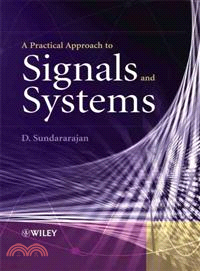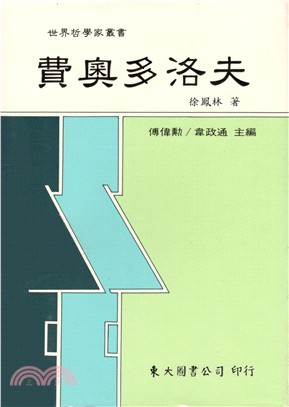PRACTICAL APPROACH TO SIGNALS AND SYSTEMS
商品資訊
定價
:NT$ 5985 元優惠價
:90 折 5387 元
若需訂購本書,請電洽客服 02-25006600[分機130、131]。
相關商品
商品簡介
作者簡介
目次
商品簡介
Concisely covers all the important concepts in an easy-to-understand way
Gaining a strong sense of signals and systems fundamentals is key for general proficiency in any electronic engineering discipline, and critical for specialists in signal processing, communication, and control. At the same time, there is a pressing need to gain mastery of these concepts quickly, and in a manner that will be immediately applicable in the real word.
Simultaneous study of both continuous and discrete signals and systems presents a much easy path to understanding signals and systems analysis. In A Practical Approach to Signals and Systems, Sundararajan details the discrete version first followed by the corresponding continuous version for each topic, as discrete signals and systems are more often used in practice and their concepts are relatively easier to understand. In addition to examples of typical applications of analysis methods, the author gives comprehensive coverage of transform methods, emphasizing practical methods of analysis and physical interpretations of concepts.
Gives equal emphasis to theory and practice
Presents methods that can be immediately applied
Complete treatment of transform methods
Expanded coverage of Fourier analysis
Self-contained: starts from the basics and discusses applications
Visual aids and examples makes the subject easier to understand
End-of-chapter exercises, with a extensive solutions manual for instructors
MATLAB software for readers to download and practice on their own
Presentation slides with book figures and slides with lecture notes
A Practical Approach to Signals and Systems is an excellent resource for the electrical engineering student or professional to quickly gain an understanding of signal analysis concepts - concepts which all electrical engineers will eventually encounter no matter what their specialization. For aspiring engineers in signal processing, communication, and control, the topics presented will form a sound foundation to their future study, while allowing them to quickly move on to more advanced topics in the area.
Scientists in chemical, mechanical, and biomedical areas will also benefit from this book, as increasing overlap with electrical engineering solutions and applications will require a working understanding of signals. Compact and self contained, A Practical Approach to Signals and Systems be used for courses or self-study, or as a reference book.
Gaining a strong sense of signals and systems fundamentals is key for general proficiency in any electronic engineering discipline, and critical for specialists in signal processing, communication, and control. At the same time, there is a pressing need to gain mastery of these concepts quickly, and in a manner that will be immediately applicable in the real word.
Simultaneous study of both continuous and discrete signals and systems presents a much easy path to understanding signals and systems analysis. In A Practical Approach to Signals and Systems, Sundararajan details the discrete version first followed by the corresponding continuous version for each topic, as discrete signals and systems are more often used in practice and their concepts are relatively easier to understand. In addition to examples of typical applications of analysis methods, the author gives comprehensive coverage of transform methods, emphasizing practical methods of analysis and physical interpretations of concepts.
Gives equal emphasis to theory and practice
Presents methods that can be immediately applied
Complete treatment of transform methods
Expanded coverage of Fourier analysis
Self-contained: starts from the basics and discusses applications
Visual aids and examples makes the subject easier to understand
End-of-chapter exercises, with a extensive solutions manual for instructors
MATLAB software for readers to download and practice on their own
Presentation slides with book figures and slides with lecture notes
A Practical Approach to Signals and Systems is an excellent resource for the electrical engineering student or professional to quickly gain an understanding of signal analysis concepts - concepts which all electrical engineers will eventually encounter no matter what their specialization. For aspiring engineers in signal processing, communication, and control, the topics presented will form a sound foundation to their future study, while allowing them to quickly move on to more advanced topics in the area.
Scientists in chemical, mechanical, and biomedical areas will also benefit from this book, as increasing overlap with electrical engineering solutions and applications will require a working understanding of signals. Compact and self contained, A Practical Approach to Signals and Systems be used for courses or self-study, or as a reference book.
作者簡介
D. Sundararajan is a consultant in digital signal processing at NewTech Software Pt. Ltd in Bangalore India. He has taught undergraduate and graduate classes in digital signal processing, engineering mathematics, programming, operating systems and digital logic design at Concordia University, Canada and Nanyang Technological Institute, Singapore. Sundararajan is the principal inventor of the latest family of Discrete Fourier Transform (DFT) algorithms, and has published two books on DFT and related areas. He also wrote a lab manual for the Digital Electronics Course at Concordia University, and has three patents in fast Fourier transforms. Over the course of his engineering career he has held positions at the National Aerospace Laboratory, Bangalore, the National Physical Laboratory, New Delhi, working on the design of digital and analog signal processing systems. Sundararajan holds a B.E. in Electrical Engineering from Madras University, an M.Tech in Electrical Engineering from IIT Chennai, and a Ph.D. in the same from Concordia University.
目次
Preface.
Abbreviations.
1 Introduction.
1.1 The Organization of this Book.
2 Discrete Signals.
2.1 Classification of Signals.
2.1.1 Continuous, Discrete, and Digital Signals.
2.1.2 Periodic and Aperiodic Signals.
2.1.3 Energy and Power Signals.
2.1.4 Even- and Odd-Symmetric Signals.
2.1.5 Causal and Noncausal Signals.
2.1.6 Deterministic and Random Signals.
2.2 Basic Signals.
2.2.1 Unit-Impulse Signal.
2.2.2 Unit-Step Signal.
2.2.3 Unit-Ramp Signal.
2.2.4 Sinusoids and Exponentials.
2.3 Signal Operations.
2.3.1 Time Shifting.
2.3.2 Time Reversal.
2.3.3 Time Scaling.
2.4 Summary.
References.
Exercises.
3 Continuous Signals.
3.1 Classification of Signals.
3.1.1 Continuous Signals.
3.1.2 Periodic and Aperiodic Signals.
3.1.3 Energy and Power Signals.
3.1.4 Even- and Odd-Symmetric Signals.
3.1.5 Causal and Noncausal Signals.
3.2 Basic Signals.
3.2.1 The Unit-Step Signal.
3.2.2 The Unit-Impulse Signal.
3.2.3 The Unit-Ramp Signal.
3.2.4 Sinusoids.
3.3 Signal Operations.
3.3.1 Time Shifting.
3.3.2 Time Reversal.
3.3.3 Time Scaling.
3.4 Summary.
Reference.
Exercises.
4 Time-Domain Analysis of Discrete Systems.
4.1 Difference Equation Model.
4.1.1 System Response.
4.1.2 Impulse Response.
4.1.3 Characterization of Systems by their Responses to Impulse and Unit-Step Signals.
4.2 Classification of Systems.
4.2.1 Linear and Nonlinear Systems.
4.2.2 Time-Invariant and Time-Varying Systems.
4.2.3 Causal and Noncausal Systems.
4.2.4 Instantaneous and Dynamic Systems.
4.2.5 Inverse Systems.
4.2.6 Continuous and Discrete Systems.
4.3 Convolution-Summation Model.
4.3.1 Properties of Convolution-Summation.
4.3.2 The Difference Equation and the Convolution-Summation.
4.3.3 Response to Complex Exponential Input.
4.4 System Stability.
4.5 Realization of Discrete Systems.
4.5.1 Decomposition of Higher-Order Systems.
4.5.2 Feedback Systems.
4.6 Summary.
References.
Exercises.
5 Time-Domain Analysis of Continuous Systems.
5.1 Classification of Systems.
5.1.1 Linear and Nonlinear Systems.
5.1.2 Time-Invariant and Time-Varying Systems.
5.1.3 Causal and Noncausal Systems.
5.1.4 Instantaneous and Dynamic Systems.
5.1.5 Lumped-Parameter and Distributed-Parameter Systems.
5.1.6 Inverse Systems.
5.2 Difference Equation Model.
5.3 Convolution-Integral Model.
5.3.1 Properties of Convolution-Integral.
5.4 System Response.
5.4.1 Impulse Response.
5.4.2 Response to Unit-Step Input.
5.4.3 Characterization of Systems by their Responses to Impulse and Unit-Step Signals.
5.4.4 Response to Complex Exponential Input.
5.5 System Stability.
5.6 Realization of Continuous Systems.
5.6.1 Decomposition of Higher-Order Systems.
5.6.2 Feedback Systems.
5.7 Summary.
Reference.
Exercises.
6 The Discrete Fourier Transform.
6.1 The Time-Domain and Frequency-Domain.
6.2 The Fourier Analysis.
6.2.1 Versions of Fourier Analysis.
6.3 The Discrete Fourier Transform.
6.3.1 The Approximation of Arbitrary Waveforms with Finite Number Samples.
6.3.2 The DFT and the IDFT.
6.3.3 DFT of Some Basic Signals.
6.4 Properties of the Discrete Fourier Transform.
6.4.1 Linearity.
6.4.2 Periodicity.
6.4.3 Circular Shift of a Sequence.
6.4.4 Circular Shift of a Spectrum.
6.4.5 Symmetry.
6.4.6 Circular Convolution of Time-Domain Sequences.
6.4.7 Circular Convolution of Frequency-Domain Sequences.
6.4.8 Parseval's Theorem.
6.5 Applications of the Discrete Fourier Transform.
6.5.1 Computation of the Linear Convolution Using the DFT.
6.5.2 Interpolation and Decimation.
6.6. Summary.
References.
Exercises.
7 Fourier Series.
7.1 Fourier Series.
7.1.1 FS as the Limiting Case of the DFT.
7.1.2 The Compact Trigonometric Form of the FS.
7.1.3 The Trigonometric Form of the FS.
7.1.4 Periodicity of the FS.
7.1.5 Existence of the FS.
7.1.6 Gibbs Phenomenon.
7.2 Properties of the Fourier Series.
7.2.1 Linearity.
7.2.2 Symmetry.
7.2.3 Time-Shifting.
7.2.4 Frequency-Shifting.
7.2.5 Convolution in the Time-Domain.
7.2.6 Convolution in the Frequency-Domain.
7.2.7 Duality.
7.2.8 Time-Scaling.
7.2.9 Time-Differentiation.
7.2.10 Time-Integration.
7.2.11 Parseval's Theorem.
7.3 Approximation of the Fourier Series.
7.3.1 Aliasing Effect.
7.4 Applications of the Fourier Series.
7.5 Summary.
References.
Exercises.
8 The Discrete-Time Fourier Transform.
8.1 The Discrete-Time Fourier Transform.
8.1.1 The DTFT as the Limiting Case of the DFT.
8.1.2 The Dual Relationship Between the DTFT and the FS.
8.1.3 The DTFT of a Discrete Periodic Signal.
8.1.4 Determination of the DFT from the DTFT.
8.2 Properties of the Discrete-Time Fourier Transform.
8.2.1 Linearity.
8.2.2 Time-Shifting.
8.2.3 Frequency-Shifting.
8.2.4 Convolution in the Time-Domain.
8.2.5 Convolution in the Frequency-Domain.
8.2.6 Symmetry.
8.2.7 Time-Reversal.
8.2.8 Time-Expansion.
8.2.9 Frequency-Differentiation.
8.2.10 Difference.
8.2.11 Summation.
8.2.12 Parseval's Theorem and the Energy Transfer Function.
8.3 Approximation of the Discrete-Time Fourier Transform.
8.3.1 Approximation of the Inverse DTFT by the IDFT.
8.4 Applications of the Discrete-Time Fourier Transform.
8.4.1 Transfer Function and the System Response.
8.4.2 Digital Filter Design Using DTFT.
8.4.3 Digital Differentiator.
8.4.4 Hilbert Transform.
8.5 Summary.
References.
Exercises.
9 The Fourier Transform.
9.1 The Fourier Transform.
9.1.1 The FT as the Limiting Case of the DTFT.
9.1.2 Existence of the FT.
9.2 Properties of the Fourier Transform.
9.2.1 Linearity.
9.2.2 Duality.
9.2.3 Symmetry.
9.2.4 Time-Shifting.
9.2.5 Frequency-Shifting.
9.2.6 Convolution in the Time-Domain.
9.2.7 Convolution in the Frequency-Domain.
9.2.8 Conjugation.
9.2.9 Time-Reversal.
9.2.10 Time-Scaling.
9.2.11 Time-Differentiation.
9.2.12 Time-Integration.
9.2.13 Frequency-Differentiation.
9.2.14 Parseval's Theorem and the Energy Transfer Function.
9.3 Fourier Transform of Mixed Class Signals.
9.3.1 The FT of a Continuous Periodic Signal.
9.3.2 Determination of the FS from the FT.
9.3.3 The FT of a Sampled Signal and the Aliasing Effect.
9.3.4 The FT of a Sampled Aperiodic Signal and the DTFT of the Corresponding Discrete Signal.
9.3.5 The FT of a Sampled Periodic Signal and the DFT of the Corresponding Discrete Signal.
9.3.6 Approximation of the Continuous Signal from its Sampled Version.
9.4 Approximation of the Fourier Transform.
9.5 Applications of the Fourier Transform.
9.5.1 Transfer Function and the System Response.
9.5.2 Ideal Filters and their Unrealizability.
9.5.3 Modulation and Demodulation.
9.6 Summary.
References.
Exercises.
10 The z-Transform.
10.1 Fourier Analysis and the z-Transform.
10.2 The z-Transform.
10.3 Properties of the z-Transform.
10.3.1 Linearity.
10.3.2 Left Shift of a Sequence.
10.3.3 Right Shift of a Sequence.
10.3.4 Convolution.
10.3.5 Multiplication by n.
10.3.6 Multiplication by an.
10.3.7 Summation.
10.3.8 Initial Value.
10.3.9 Final Value.
10.3.10 Transform of Semiperiodic Functions.
10.4 The Inverse z-Transform.
10.4.1 Finding the Inverse z-Transform.
10.5 Applications of the z-Transform.
10.5.1 Transfer Function and the System Response.
10.5.2 Characterization of a System by its Poles and Zeros.
10.5.3 System Stability.
10.5.4 Realization of Systems.
10.5.5 Feedback Systems.
10.6 Summary.
References.
Exercises.
11 The Laplace Transform.
11.1 The Laplace Transform.
11.1.1 Relationship Between the Laplace Transform and the z-Transform.
11.2 Properties of the Laplace Transform.
11.2.1 Linearity.
11.2.2 Time-Shifting.
11.2.3 Frequency-Shifting.
11.2.4 Time-Differentiation.
11.2.5 Integration.
11.2.6 Time-Scaling.
11.2.7 Convolution in Time.
11.2.8 Multiplication by t.
11.2.9 Initial Value.
11.2.10 Final Value.
11.2.11 Transform of Semiperiodic Functions.
11.3 The Inverse Laplace Transform.
11.4 Applications of the Laplace Transform.
11.4.1 Transfer Function and the System Response.
11.4.2 Characterization of a System by its Poles and Zeros.
11.4.3 System Stability.
11.4.4 Realization of Systems.
11.4.5 Frequency-Domain Representation of Circuits.
11.4.6 Feedback Systems.
11.4.7 Analog Filters.
11.5 Summary.
Reference.
Exercises.
12 State-Space Analysis of Discrete Systems.
12.1 The State-Space Model.
12.1.1 Parallel Realization.
12.1.2 Cascade Realization.
12.2 Time-Domain Solution of the State Equation.
12.2.1 Iterative Solution.
12.2.2 Closed-Form Solution.
12.2.3 The Impulse Response.
12.3 Frequency-Domain Solution of the State Equation.
12.4 Linear Transformation of State Vectors.
12.5 Summary.
Reference.
Exercises.
13 State-Space Analysis of Continuous Systems.
13.1 The State-Space Model.
13.2 Time-Domain Solution of the State Equation.
13.3 Frequency-Domain Solution of the State Equation.
13.4 Linear Transformation of State Vectors.
13.5 Summary.
Reference.
Exercises.
Appendix A Transform Pairs and Properties.
Appendix B Useful Mathematical Formulas.
Answers to Selected Exercises.
Index.
Abbreviations.
1 Introduction.
1.1 The Organization of this Book.
2 Discrete Signals.
2.1 Classification of Signals.
2.1.1 Continuous, Discrete, and Digital Signals.
2.1.2 Periodic and Aperiodic Signals.
2.1.3 Energy and Power Signals.
2.1.4 Even- and Odd-Symmetric Signals.
2.1.5 Causal and Noncausal Signals.
2.1.6 Deterministic and Random Signals.
2.2 Basic Signals.
2.2.1 Unit-Impulse Signal.
2.2.2 Unit-Step Signal.
2.2.3 Unit-Ramp Signal.
2.2.4 Sinusoids and Exponentials.
2.3 Signal Operations.
2.3.1 Time Shifting.
2.3.2 Time Reversal.
2.3.3 Time Scaling.
2.4 Summary.
References.
Exercises.
3 Continuous Signals.
3.1 Classification of Signals.
3.1.1 Continuous Signals.
3.1.2 Periodic and Aperiodic Signals.
3.1.3 Energy and Power Signals.
3.1.4 Even- and Odd-Symmetric Signals.
3.1.5 Causal and Noncausal Signals.
3.2 Basic Signals.
3.2.1 The Unit-Step Signal.
3.2.2 The Unit-Impulse Signal.
3.2.3 The Unit-Ramp Signal.
3.2.4 Sinusoids.
3.3 Signal Operations.
3.3.1 Time Shifting.
3.3.2 Time Reversal.
3.3.3 Time Scaling.
3.4 Summary.
Reference.
Exercises.
4 Time-Domain Analysis of Discrete Systems.
4.1 Difference Equation Model.
4.1.1 System Response.
4.1.2 Impulse Response.
4.1.3 Characterization of Systems by their Responses to Impulse and Unit-Step Signals.
4.2 Classification of Systems.
4.2.1 Linear and Nonlinear Systems.
4.2.2 Time-Invariant and Time-Varying Systems.
4.2.3 Causal and Noncausal Systems.
4.2.4 Instantaneous and Dynamic Systems.
4.2.5 Inverse Systems.
4.2.6 Continuous and Discrete Systems.
4.3 Convolution-Summation Model.
4.3.1 Properties of Convolution-Summation.
4.3.2 The Difference Equation and the Convolution-Summation.
4.3.3 Response to Complex Exponential Input.
4.4 System Stability.
4.5 Realization of Discrete Systems.
4.5.1 Decomposition of Higher-Order Systems.
4.5.2 Feedback Systems.
4.6 Summary.
References.
Exercises.
5 Time-Domain Analysis of Continuous Systems.
5.1 Classification of Systems.
5.1.1 Linear and Nonlinear Systems.
5.1.2 Time-Invariant and Time-Varying Systems.
5.1.3 Causal and Noncausal Systems.
5.1.4 Instantaneous and Dynamic Systems.
5.1.5 Lumped-Parameter and Distributed-Parameter Systems.
5.1.6 Inverse Systems.
5.2 Difference Equation Model.
5.3 Convolution-Integral Model.
5.3.1 Properties of Convolution-Integral.
5.4 System Response.
5.4.1 Impulse Response.
5.4.2 Response to Unit-Step Input.
5.4.3 Characterization of Systems by their Responses to Impulse and Unit-Step Signals.
5.4.4 Response to Complex Exponential Input.
5.5 System Stability.
5.6 Realization of Continuous Systems.
5.6.1 Decomposition of Higher-Order Systems.
5.6.2 Feedback Systems.
5.7 Summary.
Reference.
Exercises.
6 The Discrete Fourier Transform.
6.1 The Time-Domain and Frequency-Domain.
6.2 The Fourier Analysis.
6.2.1 Versions of Fourier Analysis.
6.3 The Discrete Fourier Transform.
6.3.1 The Approximation of Arbitrary Waveforms with Finite Number Samples.
6.3.2 The DFT and the IDFT.
6.3.3 DFT of Some Basic Signals.
6.4 Properties of the Discrete Fourier Transform.
6.4.1 Linearity.
6.4.2 Periodicity.
6.4.3 Circular Shift of a Sequence.
6.4.4 Circular Shift of a Spectrum.
6.4.5 Symmetry.
6.4.6 Circular Convolution of Time-Domain Sequences.
6.4.7 Circular Convolution of Frequency-Domain Sequences.
6.4.8 Parseval's Theorem.
6.5 Applications of the Discrete Fourier Transform.
6.5.1 Computation of the Linear Convolution Using the DFT.
6.5.2 Interpolation and Decimation.
6.6. Summary.
References.
Exercises.
7 Fourier Series.
7.1 Fourier Series.
7.1.1 FS as the Limiting Case of the DFT.
7.1.2 The Compact Trigonometric Form of the FS.
7.1.3 The Trigonometric Form of the FS.
7.1.4 Periodicity of the FS.
7.1.5 Existence of the FS.
7.1.6 Gibbs Phenomenon.
7.2 Properties of the Fourier Series.
7.2.1 Linearity.
7.2.2 Symmetry.
7.2.3 Time-Shifting.
7.2.4 Frequency-Shifting.
7.2.5 Convolution in the Time-Domain.
7.2.6 Convolution in the Frequency-Domain.
7.2.7 Duality.
7.2.8 Time-Scaling.
7.2.9 Time-Differentiation.
7.2.10 Time-Integration.
7.2.11 Parseval's Theorem.
7.3 Approximation of the Fourier Series.
7.3.1 Aliasing Effect.
7.4 Applications of the Fourier Series.
7.5 Summary.
References.
Exercises.
8 The Discrete-Time Fourier Transform.
8.1 The Discrete-Time Fourier Transform.
8.1.1 The DTFT as the Limiting Case of the DFT.
8.1.2 The Dual Relationship Between the DTFT and the FS.
8.1.3 The DTFT of a Discrete Periodic Signal.
8.1.4 Determination of the DFT from the DTFT.
8.2 Properties of the Discrete-Time Fourier Transform.
8.2.1 Linearity.
8.2.2 Time-Shifting.
8.2.3 Frequency-Shifting.
8.2.4 Convolution in the Time-Domain.
8.2.5 Convolution in the Frequency-Domain.
8.2.6 Symmetry.
8.2.7 Time-Reversal.
8.2.8 Time-Expansion.
8.2.9 Frequency-Differentiation.
8.2.10 Difference.
8.2.11 Summation.
8.2.12 Parseval's Theorem and the Energy Transfer Function.
8.3 Approximation of the Discrete-Time Fourier Transform.
8.3.1 Approximation of the Inverse DTFT by the IDFT.
8.4 Applications of the Discrete-Time Fourier Transform.
8.4.1 Transfer Function and the System Response.
8.4.2 Digital Filter Design Using DTFT.
8.4.3 Digital Differentiator.
8.4.4 Hilbert Transform.
8.5 Summary.
References.
Exercises.
9 The Fourier Transform.
9.1 The Fourier Transform.
9.1.1 The FT as the Limiting Case of the DTFT.
9.1.2 Existence of the FT.
9.2 Properties of the Fourier Transform.
9.2.1 Linearity.
9.2.2 Duality.
9.2.3 Symmetry.
9.2.4 Time-Shifting.
9.2.5 Frequency-Shifting.
9.2.6 Convolution in the Time-Domain.
9.2.7 Convolution in the Frequency-Domain.
9.2.8 Conjugation.
9.2.9 Time-Reversal.
9.2.10 Time-Scaling.
9.2.11 Time-Differentiation.
9.2.12 Time-Integration.
9.2.13 Frequency-Differentiation.
9.2.14 Parseval's Theorem and the Energy Transfer Function.
9.3 Fourier Transform of Mixed Class Signals.
9.3.1 The FT of a Continuous Periodic Signal.
9.3.2 Determination of the FS from the FT.
9.3.3 The FT of a Sampled Signal and the Aliasing Effect.
9.3.4 The FT of a Sampled Aperiodic Signal and the DTFT of the Corresponding Discrete Signal.
9.3.5 The FT of a Sampled Periodic Signal and the DFT of the Corresponding Discrete Signal.
9.3.6 Approximation of the Continuous Signal from its Sampled Version.
9.4 Approximation of the Fourier Transform.
9.5 Applications of the Fourier Transform.
9.5.1 Transfer Function and the System Response.
9.5.2 Ideal Filters and their Unrealizability.
9.5.3 Modulation and Demodulation.
9.6 Summary.
References.
Exercises.
10 The z-Transform.
10.1 Fourier Analysis and the z-Transform.
10.2 The z-Transform.
10.3 Properties of the z-Transform.
10.3.1 Linearity.
10.3.2 Left Shift of a Sequence.
10.3.3 Right Shift of a Sequence.
10.3.4 Convolution.
10.3.5 Multiplication by n.
10.3.6 Multiplication by an.
10.3.7 Summation.
10.3.8 Initial Value.
10.3.9 Final Value.
10.3.10 Transform of Semiperiodic Functions.
10.4 The Inverse z-Transform.
10.4.1 Finding the Inverse z-Transform.
10.5 Applications of the z-Transform.
10.5.1 Transfer Function and the System Response.
10.5.2 Characterization of a System by its Poles and Zeros.
10.5.3 System Stability.
10.5.4 Realization of Systems.
10.5.5 Feedback Systems.
10.6 Summary.
References.
Exercises.
11 The Laplace Transform.
11.1 The Laplace Transform.
11.1.1 Relationship Between the Laplace Transform and the z-Transform.
11.2 Properties of the Laplace Transform.
11.2.1 Linearity.
11.2.2 Time-Shifting.
11.2.3 Frequency-Shifting.
11.2.4 Time-Differentiation.
11.2.5 Integration.
11.2.6 Time-Scaling.
11.2.7 Convolution in Time.
11.2.8 Multiplication by t.
11.2.9 Initial Value.
11.2.10 Final Value.
11.2.11 Transform of Semiperiodic Functions.
11.3 The Inverse Laplace Transform.
11.4 Applications of the Laplace Transform.
11.4.1 Transfer Function and the System Response.
11.4.2 Characterization of a System by its Poles and Zeros.
11.4.3 System Stability.
11.4.4 Realization of Systems.
11.4.5 Frequency-Domain Representation of Circuits.
11.4.6 Feedback Systems.
11.4.7 Analog Filters.
11.5 Summary.
Reference.
Exercises.
12 State-Space Analysis of Discrete Systems.
12.1 The State-Space Model.
12.1.1 Parallel Realization.
12.1.2 Cascade Realization.
12.2 Time-Domain Solution of the State Equation.
12.2.1 Iterative Solution.
12.2.2 Closed-Form Solution.
12.2.3 The Impulse Response.
12.3 Frequency-Domain Solution of the State Equation.
12.4 Linear Transformation of State Vectors.
12.5 Summary.
Reference.
Exercises.
13 State-Space Analysis of Continuous Systems.
13.1 The State-Space Model.
13.2 Time-Domain Solution of the State Equation.
13.3 Frequency-Domain Solution of the State Equation.
13.4 Linear Transformation of State Vectors.
13.5 Summary.
Reference.
Exercises.
Appendix A Transform Pairs and Properties.
Appendix B Useful Mathematical Formulas.
Answers to Selected Exercises.
Index.
主題書展
更多
主題書展
更多書展本週66折
您曾經瀏覽過的商品
購物須知
外文書商品之書封,為出版社提供之樣本。實際出貨商品,以出版社所提供之現有版本為主。部份書籍,因出版社供應狀況特殊,匯率將依實際狀況做調整。
無庫存之商品,在您完成訂單程序之後,將以空運的方式為你下單調貨。為了縮短等待的時間,建議您將外文書與其他商品分開下單,以獲得最快的取貨速度,平均調貨時間為1~2個月。
為了保護您的權益,「三民網路書店」提供會員七日商品鑑賞期(收到商品為起始日)。
若要辦理退貨,請在商品鑑賞期內寄回,且商品必須是全新狀態與完整包裝(商品、附件、發票、隨貨贈品等)否則恕不接受退貨。























